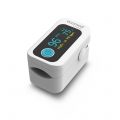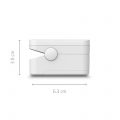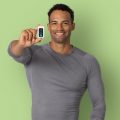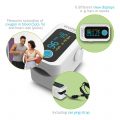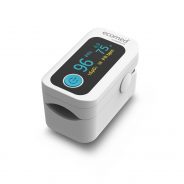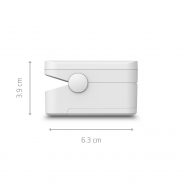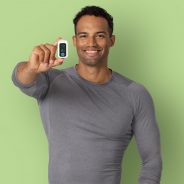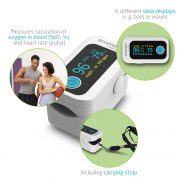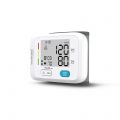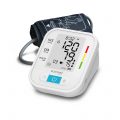Pulse Oximeter
PM-30E
Item number: 23650
Pulse Oximeter
PM-30E
Item number: 23650
Pulse Oximeter for measuring blood oxygen saturation (SpO2%) and heart rate
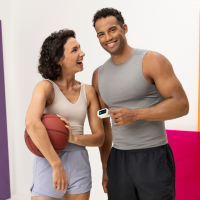
- Pulse Oximeter for measuring blood oxygen saturation (Sp02%) and heart rate (pulse)
- Measurement display on 2-color OLED display
- 6 different displays
- Simple “one touch” operation – ideal for on the go
- Oxygen saturation (SpO2) and pulse rate can be displayed in bar or wave form
- Adjustable display brightness in 5 levels
- Display of the perfusion index (PI) (pulse intensity)
- Automatic switch-off after 15 seconds
- Battery change indicator
- Carrying strap included
- Certified medical device
Already seen it?
Pulse Oximeter – Measuring Oxygen Saturation Made Easy
A small clip on your finger that shows you in seconds how your body is really doing: a pulse oximeter measures your blood oxygen level and pulse—two key indicators that provide valuable insights into your health.
Whether at home, during exercise, or in challenging environments like high altitudes, this device provides instant clarity.
For people with chronic conditions such as COPD or asthma, it is an essential device for keeping track of their health. But even for healthy individuals, a pulse oximeter can be highly beneficial — for example, to gain a clearer picture of their fitness levels or to minimise strain on the body.
A reliable, user-friendly tool that offers valuable support whenever you need it.
Monitor Oxygen Saturation and Pulse – The Benefits of a Pulse Oximeter
How can a pulse oximeter provide such accurate readings? The technology behind it is more advanced than it appears — yet surprisingly simple and fascinating.
A pulse oximeter measures your oxygen saturation (SpO₂%) using light and sensors. It emits two beams of light at different wavelengths through your finger and analyses how much light is absorbed by your blood.
The result? A highly accurate measurement of your oxygen levels, along with your heart rate — and in modern finger pulse oximeters, even your pulse strength (Perfusion Index, PI).
Why the Finger Is the Best Place for Measurement:
• Thin skin layers: The skin on the finger is thin enough for light to pass through efficiently, ensuring an accurate reading.
• Highly perfused area: The arteries in the finger provide consistent and highly reliable results.
• Practical and easy to use: The finger clip is simply to apply — just attach it, check the results, and you’re done.
A pulse oximeter is a versatile health tool. While a blood pressure monitor focuses on circulatory health and a clinical thermometer provides clarity during acute symptoms, a pulse oximeter delivers real-time data for a more complete picture of your body — all in just a few seconds.
It is suitable for use at home, while travelling, or during exercise.
Measuring Blood Oxygen – A Key Part of Accurate Health Monitoring
For many, a pulse oximeter is more than just a medical device — it can play a vital role in managing health.
Monitoring oxygen saturation is particularly important for those with chronic conditions such as COPD or asthma. Regular checks with a reliable medical device help detect changes early, making timely action possible. Similarly, individuals with heart conditions that affect oxygen supply can benefit from the valuable insights this health device provides.
The COVID-19 pandemic highlighted the importance of tracking oxygen saturation: declining levels can serve as an early warning sign, even before noticeable symptoms develop.
With a pulse oximeter, you’re not just looking at numbers — you’re gaining key insights to help you take control of your health. A small device that makes a big difference.
Pulse Oximeter in Sports and Daily Life – Your Personal Fitness Monitor
Even if you’re in good health, a pulse oximeter can be a valuable tool — especially if you lead an active, sporty lifestyle. It delivers accurate data, helping you monitor your health with greater precision.
• Use in endurance training: Whether you’re running or cycling, a pulse oximeter helps you track how well your body is absorbing oxygen. A drop in levels can indicate the need for a break or an adjustment in intensity — supporting efficient and safe training.
• Support for breathing techniques: Practising Pranayama in yoga or focusing on controlled breathing exercises? A pulse oximeter provides real-time feedback on how your breathing affects oxygen levels. This encourages deeper breaths and helps refine your technique.
• Managing high altitudes: Planning a hiking trip in the mountains? At higher altitudes, oxygen saturation can decrease. A pulse oximeter helps you detect early signs of altitude sickness, allowing you to stay safe and fully enjoy your adventure.
A pulse oximeter (or oximeter) isn’t just a device for medical use — it’s your personal fitness coach, helping you develop a deeper awareness of your body and get the most out of your training and daily life.
Medical Facts and Critical Values – What a Pulse Oximeter Reveals
If you’re considering buying a pulse oximeter, it’s important to understand the readings it provides.
Your blood oxygen saturation (SpO₂) is measured as a percentage and indicates how well your body is supplied with oxygen. Normal levels range between 95% and 100%, indicating a healthy oxygen supply.
However, readings below 90% are considered critical and may indicate respiratory diseases, cardiovascular disorders, or oxygen deficiency.
• 95–100%: Healthy range—your body is getting the oxygen it needs.
• 90–94%: Caution—potential oxygen deficiency, which may be due to illness, exertion, stress, or high altitudes.
• Below 90%: A cause for concern— consult a doctor to determine the underlying causes.
If your oxygen saturation drops below 90%, you should not hesitate to seek medical advice. And what about your pulse? It offers valuable insight into your heart rate and how your heart responds to exertion. Normal resting values for adults range from 60 to 80 beats per minute (bpm). A low resting heart rate indicates that your heart is working efficiently — in elite athletes, it can drop as low as 30–40 bpm. Recreational athletes typically have a resting heart rate of 60–70 bpm, while less active individuals often fall within the 70–90 bpm range.
A rapid pulse combined with low oxygen levels could indicate physical overexertion or stress, whereas a steady heart rate with normal SpO₂ values suggests a well-balanced system. However, heart rate is highly adaptable: it increases during exercise to supply oxygen efficiently and then gradually lowers during recovery. Using a pulse oximeter, you can track how your heart responds to exertion and recovery — both fascinating and insightful!
